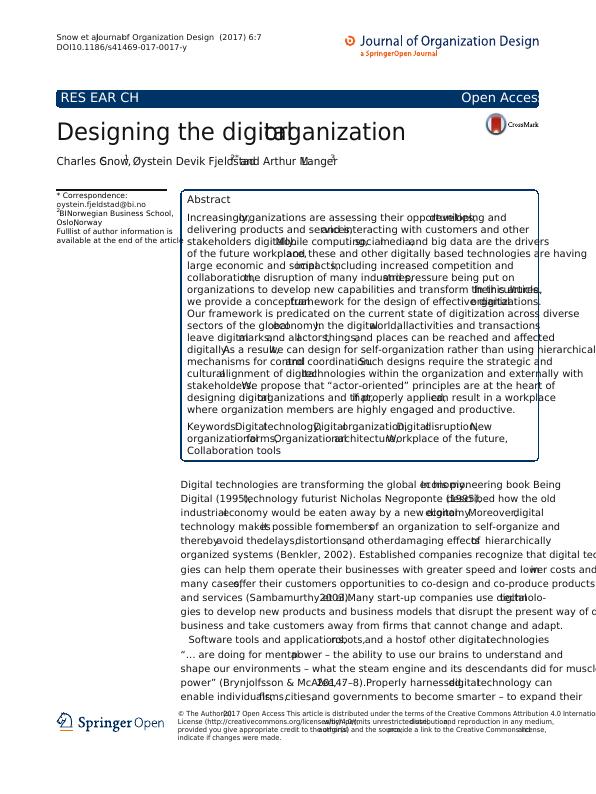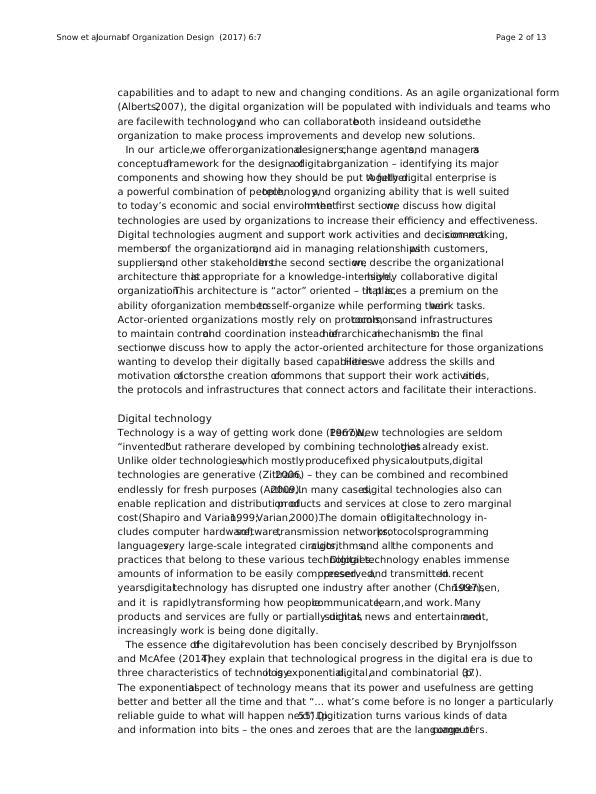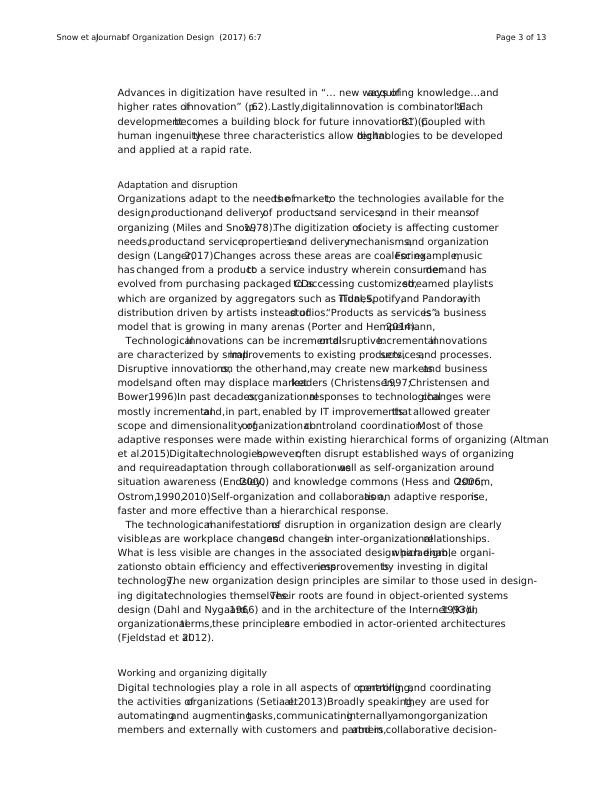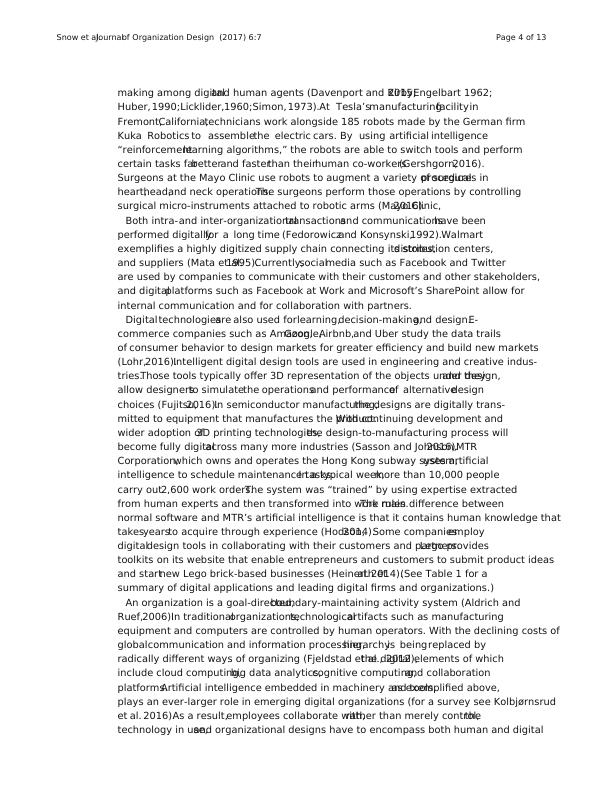(PDF) Designing the digital organization
Added on 2021-11-16
13 Pages8695 Words83 Views
RES EAR CH Open Access
Designing the digitalorganization
Charles C.Snow1,Øystein Devik Fjeldstad2*and Arthur M.Langer3
* Correspondence:
oystein.fjeldstad@bi.no2BINorwegian Business School,
Oslo,Norway
Fulllist of author information is
available at the end of the article
Abstract
Increasingly,organizations are assessing their opportunities,developing and
delivering products and services,and interacting with customers and other
stakeholders digitally.Mobile computing,socialmedia,and big data are the drivers
of the future workplace,and these and other digitally based technologies are having
large economic and socialimpacts,including increased competition and
collaboration,the disruption of many industries,and pressure being put on
organizations to develop new capabilities and transform their cultures.In this article,
we provide a conceptualframework for the design of effective digitalorganizations.
Our framework is predicated on the current state of digitization across diverse
sectors of the globaleconomy.In the digitalworld,allactivities and transactions
leave digitalmarks,and allactors,things,and places can be reached and affected
digitally.As a result,we can design for self-organization rather than using hierarchical
mechanisms for controland coordination.Such designs require the strategic and
culturalalignment of digitaltechnologies within the organization and externally with
stakeholders.We propose that “actor-oriented” principles are at the heart of
designing digitalorganizations and that,if properly applied,can result in a workplace
where organization members are highly engaged and productive.
Keywords:Digitaltechnology,Digitalorganization,Digitaldisruption,New
organizationalforms,Organizationalarchitecture,Workplace of the future,
Collaboration tools
Digital technologies are transforming the global economy.In his pioneering book Being
Digital (1995),technology futurist Nicholas Negroponte (1995),described how the old
industrialeconomy would be eaten away by a new digitaleconomy.Moreover,digital
technology makesit possible formembersof an organization to self-organize and
therebyavoid thedelays,distortions,and otherdamaging effectsof hierarchically
organized systems (Benkler, 2002). Established companies recognize that digital technolo-
gies can help them operate their businesses with greater speed and lower costs and,in
many cases,offer their customers opportunities to co-design and co-produce products
and services (Sambamurthy et al.2003).Many start-up companies use digitaltechnolo-
gies to develop new products and business models that disrupt the present way of doing
business and take customers away from firms that cannot change and adapt.
Software tools and applications,robots,and a hostof other digitaltechnologies
“... are doing for mentalpower – the ability to use our brains to understand and
shape our environments – what the steam engine and its descendants did for muscle
power” (Brynjolfsson & McAfee,2014:7–8).Properly harnessed,digitaltechnology can
enable individuals,firms,cities,and governments to become smarter – to expand their
© The Author(s).2017 Open Access This article is distributed under the terms of the Creative Commons Attribution 4.0 International
License (http://creativecommons.org/licenses/by/4.0/),which permits unrestricted use,distribution,and reproduction in any medium,
provided you give appropriate credit to the originalauthor(s) and the source,provide a link to the Creative Commons license,and
indicate if changes were made.
Snow et al.Journalof Organization Design (2017) 6:7
DOI10.1186/s41469-017-0017-y
Designing the digitalorganization
Charles C.Snow1,Øystein Devik Fjeldstad2*and Arthur M.Langer3
* Correspondence:
oystein.fjeldstad@bi.no2BINorwegian Business School,
Oslo,Norway
Fulllist of author information is
available at the end of the article
Abstract
Increasingly,organizations are assessing their opportunities,developing and
delivering products and services,and interacting with customers and other
stakeholders digitally.Mobile computing,socialmedia,and big data are the drivers
of the future workplace,and these and other digitally based technologies are having
large economic and socialimpacts,including increased competition and
collaboration,the disruption of many industries,and pressure being put on
organizations to develop new capabilities and transform their cultures.In this article,
we provide a conceptualframework for the design of effective digitalorganizations.
Our framework is predicated on the current state of digitization across diverse
sectors of the globaleconomy.In the digitalworld,allactivities and transactions
leave digitalmarks,and allactors,things,and places can be reached and affected
digitally.As a result,we can design for self-organization rather than using hierarchical
mechanisms for controland coordination.Such designs require the strategic and
culturalalignment of digitaltechnologies within the organization and externally with
stakeholders.We propose that “actor-oriented” principles are at the heart of
designing digitalorganizations and that,if properly applied,can result in a workplace
where organization members are highly engaged and productive.
Keywords:Digitaltechnology,Digitalorganization,Digitaldisruption,New
organizationalforms,Organizationalarchitecture,Workplace of the future,
Collaboration tools
Digital technologies are transforming the global economy.In his pioneering book Being
Digital (1995),technology futurist Nicholas Negroponte (1995),described how the old
industrialeconomy would be eaten away by a new digitaleconomy.Moreover,digital
technology makesit possible formembersof an organization to self-organize and
therebyavoid thedelays,distortions,and otherdamaging effectsof hierarchically
organized systems (Benkler, 2002). Established companies recognize that digital technolo-
gies can help them operate their businesses with greater speed and lower costs and,in
many cases,offer their customers opportunities to co-design and co-produce products
and services (Sambamurthy et al.2003).Many start-up companies use digitaltechnolo-
gies to develop new products and business models that disrupt the present way of doing
business and take customers away from firms that cannot change and adapt.
Software tools and applications,robots,and a hostof other digitaltechnologies
“... are doing for mentalpower – the ability to use our brains to understand and
shape our environments – what the steam engine and its descendants did for muscle
power” (Brynjolfsson & McAfee,2014:7–8).Properly harnessed,digitaltechnology can
enable individuals,firms,cities,and governments to become smarter – to expand their
© The Author(s).2017 Open Access This article is distributed under the terms of the Creative Commons Attribution 4.0 International
License (http://creativecommons.org/licenses/by/4.0/),which permits unrestricted use,distribution,and reproduction in any medium,
provided you give appropriate credit to the originalauthor(s) and the source,provide a link to the Creative Commons license,and
indicate if changes were made.
Snow et al.Journalof Organization Design (2017) 6:7
DOI10.1186/s41469-017-0017-y

capabilities and to adapt to new and changing conditions. As an agile organizational form
(Alberts,2007), the digital organization will be populated with individuals and teams who
are facilewith technologyand who can collaborateboth insideand outsidethe
organization to make process improvements and develop new solutions.
In our article,we offerorganizationaldesigners,change agents,and managersa
conceptualframework for the design ofa digitalorganization – identifying its major
components and showing how they should be put together.A fully digital enterprise is
a powerful combination of people,technology,and organizing ability that is well suited
to today’s economic and social environment.In the first section,we discuss how digital
technologies are used by organizations to increase their efficiency and effectiveness.
Digital technologies augment and support work activities and decision-making,connect
membersof the organization,and aid in managing relationshipswith customers,
suppliers,and other stakeholders.In the second section,we describe the organizational
architecture thatis appropriate for a knowledge-intensive,highly collaborative digital
organization.This architecture is “actor” oriented – that is,it places a premium on the
ability oforganization membersto self-organize while performing theirwork tasks.
Actor-oriented organizations mostly rely on protocols,commons,and infrastructures
to maintain controland coordination instead ofhierarchicalmechanisms.In the final
section,we discuss how to apply the actor-oriented architecture for those organizations
wanting to develop their digitally based capabilities.Here we address the skills and
motivation ofactors,the creation ofcommons that support their work activities,and
the protocols and infrastructures that connect actors and facilitate their interactions.
Digital technology
Technology is a way of getting work done (Perrow,1967).New technologies are seldom
“invented”but ratherare developed by combining technologiesthatalready exist.
Unlike older technologies,which mostlyproducefixed physicaloutputs,digital
technologies are generative (Zittrain,2006) – they can be combined and recombined
endlessly for fresh purposes (Arthur,2009).In many cases,digital technologies also can
enable replication and distribution ofproducts and services at close to zero marginal
cost(Shapiro and Varian,1999;Varian,2000).The domain ofdigitaltechnology in-
cludes computer hardware,software,transmission networks,protocols,programming
languages,very large-scale integrated circuits,algorithms,and allthe components and
practices that belong to these various technologies.Digital technology enables immense
amounts of information to be easily compressed,preserved,and transmitted.In recent
years,digitaltechnology has disrupted one industry after another (Christensen,1997),
and it is rapidlytransforming how peoplecommunicate,learn,and work.Many
products and services are fully or partially digital,such as news and entertainment,and
increasingly work is being done digitally.
The essence ofthe digitalrevolution has been concisely described by Brynjolfsson
and McAfee (2014).They explain that technological progress in the digital era is due to
three characteristics of technology:it is exponential,digital,and combinatorial (p.37).
The exponentialaspect of technology means that its power and usefulness are getting
better and better all the time and that “... what’s come before is no longer a particularly
reliable guide to what will happen next” (p.55).Digitization turns various kinds of data
and information into bits – the ones and zeroes that are the language ofcomputers.
Snow et al.Journalof Organization Design (2017) 6:7 Page 2 of 13
(Alberts,2007), the digital organization will be populated with individuals and teams who
are facilewith technologyand who can collaborateboth insideand outsidethe
organization to make process improvements and develop new solutions.
In our article,we offerorganizationaldesigners,change agents,and managersa
conceptualframework for the design ofa digitalorganization – identifying its major
components and showing how they should be put together.A fully digital enterprise is
a powerful combination of people,technology,and organizing ability that is well suited
to today’s economic and social environment.In the first section,we discuss how digital
technologies are used by organizations to increase their efficiency and effectiveness.
Digital technologies augment and support work activities and decision-making,connect
membersof the organization,and aid in managing relationshipswith customers,
suppliers,and other stakeholders.In the second section,we describe the organizational
architecture thatis appropriate for a knowledge-intensive,highly collaborative digital
organization.This architecture is “actor” oriented – that is,it places a premium on the
ability oforganization membersto self-organize while performing theirwork tasks.
Actor-oriented organizations mostly rely on protocols,commons,and infrastructures
to maintain controland coordination instead ofhierarchicalmechanisms.In the final
section,we discuss how to apply the actor-oriented architecture for those organizations
wanting to develop their digitally based capabilities.Here we address the skills and
motivation ofactors,the creation ofcommons that support their work activities,and
the protocols and infrastructures that connect actors and facilitate their interactions.
Digital technology
Technology is a way of getting work done (Perrow,1967).New technologies are seldom
“invented”but ratherare developed by combining technologiesthatalready exist.
Unlike older technologies,which mostlyproducefixed physicaloutputs,digital
technologies are generative (Zittrain,2006) – they can be combined and recombined
endlessly for fresh purposes (Arthur,2009).In many cases,digital technologies also can
enable replication and distribution ofproducts and services at close to zero marginal
cost(Shapiro and Varian,1999;Varian,2000).The domain ofdigitaltechnology in-
cludes computer hardware,software,transmission networks,protocols,programming
languages,very large-scale integrated circuits,algorithms,and allthe components and
practices that belong to these various technologies.Digital technology enables immense
amounts of information to be easily compressed,preserved,and transmitted.In recent
years,digitaltechnology has disrupted one industry after another (Christensen,1997),
and it is rapidlytransforming how peoplecommunicate,learn,and work.Many
products and services are fully or partially digital,such as news and entertainment,and
increasingly work is being done digitally.
The essence ofthe digitalrevolution has been concisely described by Brynjolfsson
and McAfee (2014).They explain that technological progress in the digital era is due to
three characteristics of technology:it is exponential,digital,and combinatorial (p.37).
The exponentialaspect of technology means that its power and usefulness are getting
better and better all the time and that “... what’s come before is no longer a particularly
reliable guide to what will happen next” (p.55).Digitization turns various kinds of data
and information into bits – the ones and zeroes that are the language ofcomputers.
Snow et al.Journalof Organization Design (2017) 6:7 Page 2 of 13

Advances in digitization have resulted in “... new ways ofacquiring knowledge...and
higher rates ofinnovation” (p.62).Lastly,digitalinnovation is combinatorial:“Each
developmentbecomes a building block for future innovations” (p.81).Coupled with
human ingenuity,these three characteristics allow digitaltechnologies to be developed
and applied at a rapid rate.
Adaptation and disruption
Organizations adapt to the needs ofthe market;to the technologies available for the
design,production,and deliveryof productsand services;and in their meansof
organizing (Miles and Snow,1978).The digitization ofsociety is affecting customer
needs,productand servicepropertiesand deliverymechanisms,and organization
design (Langer,2017).Changes across these areas are coalescing.For example,music
haschanged from a productto a service industry wherein consumerdemand has
evolved from purchasing packaged CDsto accessing customized,streamed playlists
which are organized by aggregators such as iTunes,Tidal,Spotify,and Pandora,with
distribution driven by artists instead ofstudios.“Products as services”is a business
model that is growing in many arenas (Porter and Hempelmann,2014).
Technologicalinnovations can be incrementalor disruptive.Incrementalinnovations
are characterized by smallimprovements to existing products,services,and processes.
Disruptive innovations,on the otherhand,may create new marketsand business
models,and often may displace marketleaders (Christensen,1997;Christensen and
Bower,1996).In past decades,organizationalresponses to technologicalchanges were
mostly incrementaland,in part,enabled by IT improvementsthatallowed greater
scope and dimensionality oforganizationalcontroland coordination.Most of those
adaptive responses were made within existing hierarchical forms of organizing (Altman
et al.2015).Digitaltechnologies,however,often disrupt established ways of organizing
and requireadaptation through collaboration aswell as self-organization around
situation awareness (Endsley,2000) and knowledge commons (Hess and Ostrom,2006;
Ostrom,1990,2010).Self-organization and collaboration,as an adaptive response,is
faster and more effective than a hierarchical response.
The technologicalmanifestationsof disruption in organization design are clearly
visible,as are workplace changesand changesin inter-organizationalrelationships.
What is less visible are changes in the associated design paradigm,which enable organi-
zationsto obtain efficiency and effectivenessimprovementsby investing in digital
technology.The new organization design principles are similar to those used in design-
ing digitaltechnologies themselves.Their roots are found in object-oriented systems
design (Dahl and Nygaard,1966) and in the architecture of the Internet (Krol,1993).In
organizationalterms,these principlesare embodied in actor-oriented architectures
(Fjeldstad et al.2012).
Working and organizing digitally
Digital technologies play a role in all aspects of operating,controlling,and coordinating
the activities oforganizations (Setia etal.2013).Broadly speaking,they are used for
automatingand augmentingtasks,communicatinginternallyamongorganization
members and externally with customers and partners,and in collaborative decision-
Snow et al.Journalof Organization Design (2017) 6:7 Page 3 of 13
higher rates ofinnovation” (p.62).Lastly,digitalinnovation is combinatorial:“Each
developmentbecomes a building block for future innovations” (p.81).Coupled with
human ingenuity,these three characteristics allow digitaltechnologies to be developed
and applied at a rapid rate.
Adaptation and disruption
Organizations adapt to the needs ofthe market;to the technologies available for the
design,production,and deliveryof productsand services;and in their meansof
organizing (Miles and Snow,1978).The digitization ofsociety is affecting customer
needs,productand servicepropertiesand deliverymechanisms,and organization
design (Langer,2017).Changes across these areas are coalescing.For example,music
haschanged from a productto a service industry wherein consumerdemand has
evolved from purchasing packaged CDsto accessing customized,streamed playlists
which are organized by aggregators such as iTunes,Tidal,Spotify,and Pandora,with
distribution driven by artists instead ofstudios.“Products as services”is a business
model that is growing in many arenas (Porter and Hempelmann,2014).
Technologicalinnovations can be incrementalor disruptive.Incrementalinnovations
are characterized by smallimprovements to existing products,services,and processes.
Disruptive innovations,on the otherhand,may create new marketsand business
models,and often may displace marketleaders (Christensen,1997;Christensen and
Bower,1996).In past decades,organizationalresponses to technologicalchanges were
mostly incrementaland,in part,enabled by IT improvementsthatallowed greater
scope and dimensionality oforganizationalcontroland coordination.Most of those
adaptive responses were made within existing hierarchical forms of organizing (Altman
et al.2015).Digitaltechnologies,however,often disrupt established ways of organizing
and requireadaptation through collaboration aswell as self-organization around
situation awareness (Endsley,2000) and knowledge commons (Hess and Ostrom,2006;
Ostrom,1990,2010).Self-organization and collaboration,as an adaptive response,is
faster and more effective than a hierarchical response.
The technologicalmanifestationsof disruption in organization design are clearly
visible,as are workplace changesand changesin inter-organizationalrelationships.
What is less visible are changes in the associated design paradigm,which enable organi-
zationsto obtain efficiency and effectivenessimprovementsby investing in digital
technology.The new organization design principles are similar to those used in design-
ing digitaltechnologies themselves.Their roots are found in object-oriented systems
design (Dahl and Nygaard,1966) and in the architecture of the Internet (Krol,1993).In
organizationalterms,these principlesare embodied in actor-oriented architectures
(Fjeldstad et al.2012).
Working and organizing digitally
Digital technologies play a role in all aspects of operating,controlling,and coordinating
the activities oforganizations (Setia etal.2013).Broadly speaking,they are used for
automatingand augmentingtasks,communicatinginternallyamongorganization
members and externally with customers and partners,and in collaborative decision-
Snow et al.Journalof Organization Design (2017) 6:7 Page 3 of 13

making among digitaland human agents (Davenport and Kirby,2015;Engelbart 1962;
Huber,1990;Licklider,1960;Simon,1973).At Tesla’smanufacturingfacilityin
Fremont,California,technicians work alongside 185 robots made by the German firm
Kuka Robotics to assemblethe electric cars. By using artificial intelligence
“reinforcementlearning algorithms,” the robots are able to switch tools and perform
certain tasks farbetterand fasterthan theirhuman co-workers(Gershgorn,2016).
Surgeons at the Mayo Clinic use robots to augment a variety of surgicalprocedures in
heart,head,and neck operations.The surgeons perform those operations by controlling
surgical micro-instruments attached to robotic arms (Mayo Clinic,2016).
Both intra-and inter-organizationaltransactionsand communicationshave been
performed digitallyfor a long time (Fedorowiczand Konsynski,1992).Walmart
exemplifies a highly digitized supply chain connecting its stores,distribution centers,
and suppliers (Mata et al.1995).Currently,socialmedia such as Facebook and Twitter
are used by companies to communicate with their customers and other stakeholders,
and digitalplatforms such as Facebook at Work and Microsoft’s SharePoint allow for
internal communication and for collaboration with partners.
Digitaltechnologiesare also used forlearning,decision-making,and design.E-
commerce companies such as Amazon,Google,Airbnb,and Uber study the data trails
of consumer behavior to design markets for greater efficiency and build new markets
(Lohr,2016).Intelligent digital design tools are used in engineering and creative indus-
tries.Those tools typically offer 3D representation of the objects under design,and they
allow designersto simulatethe operationsand performanceof alternativedesign
choices (Fujitsu,2016).In semiconductor manufacturing,the designs are digitally trans-
mitted to equipment that manufactures the product.With continuing development and
wider adoption of3D printing technologies,the design-to-manufacturing process will
become fully digitalacross many more industries (Sasson and Johnson,2016).MTR
Corporation,which owns and operates the Hong Kong subway system,uses artificial
intelligence to schedule maintenance tasks.In a typical week,more than 10,000 people
carry out2,600 work orders.The system was “trained” by using expertise extracted
from human experts and then transformed into work rules.The main difference between
normal software and MTR’s artificial intelligence is that it contains human knowledge that
takesyearsto acquire through experience (Hodson,2014).Some companiesemploy
digitaldesign tools in collaborating with their customers and partners.Lego provides
toolkits on its website that enable entrepreneurs and customers to submit product ideas
and startnew Lego brick-based businesses (Heinerth etal. 2014).(See Table 1 for a
summary of digital applications and leading digital firms and organizations.)
An organization is a goal-directed,boundary-maintaining activity system (Aldrich and
Ruef,2006).In traditionalorganizations,technologicalartifacts such as manufacturing
equipment and computers are controlled by human operators. With the declining costs of
globalcommunication and information processing,hierarchyis beingreplaced by
radically different ways of organizing (Fjeldstad et al., 2012),the digital elements of which
include cloud computing,big data analytics,cognitive computing,and collaboration
platforms.Artificial intelligence embedded in machinery and tools,as exemplified above,
plays an ever-larger role in emerging digital organizations (for a survey see Kolbjørnsrud
et al. 2016).As a result,employees collaborate with,rather than merely control,the
technology in use,and organizational designs have to encompass both human and digital
Snow et al.Journalof Organization Design (2017) 6:7 Page 4 of 13
Huber,1990;Licklider,1960;Simon,1973).At Tesla’smanufacturingfacilityin
Fremont,California,technicians work alongside 185 robots made by the German firm
Kuka Robotics to assemblethe electric cars. By using artificial intelligence
“reinforcementlearning algorithms,” the robots are able to switch tools and perform
certain tasks farbetterand fasterthan theirhuman co-workers(Gershgorn,2016).
Surgeons at the Mayo Clinic use robots to augment a variety of surgicalprocedures in
heart,head,and neck operations.The surgeons perform those operations by controlling
surgical micro-instruments attached to robotic arms (Mayo Clinic,2016).
Both intra-and inter-organizationaltransactionsand communicationshave been
performed digitallyfor a long time (Fedorowiczand Konsynski,1992).Walmart
exemplifies a highly digitized supply chain connecting its stores,distribution centers,
and suppliers (Mata et al.1995).Currently,socialmedia such as Facebook and Twitter
are used by companies to communicate with their customers and other stakeholders,
and digitalplatforms such as Facebook at Work and Microsoft’s SharePoint allow for
internal communication and for collaboration with partners.
Digitaltechnologiesare also used forlearning,decision-making,and design.E-
commerce companies such as Amazon,Google,Airbnb,and Uber study the data trails
of consumer behavior to design markets for greater efficiency and build new markets
(Lohr,2016).Intelligent digital design tools are used in engineering and creative indus-
tries.Those tools typically offer 3D representation of the objects under design,and they
allow designersto simulatethe operationsand performanceof alternativedesign
choices (Fujitsu,2016).In semiconductor manufacturing,the designs are digitally trans-
mitted to equipment that manufactures the product.With continuing development and
wider adoption of3D printing technologies,the design-to-manufacturing process will
become fully digitalacross many more industries (Sasson and Johnson,2016).MTR
Corporation,which owns and operates the Hong Kong subway system,uses artificial
intelligence to schedule maintenance tasks.In a typical week,more than 10,000 people
carry out2,600 work orders.The system was “trained” by using expertise extracted
from human experts and then transformed into work rules.The main difference between
normal software and MTR’s artificial intelligence is that it contains human knowledge that
takesyearsto acquire through experience (Hodson,2014).Some companiesemploy
digitaldesign tools in collaborating with their customers and partners.Lego provides
toolkits on its website that enable entrepreneurs and customers to submit product ideas
and startnew Lego brick-based businesses (Heinerth etal. 2014).(See Table 1 for a
summary of digital applications and leading digital firms and organizations.)
An organization is a goal-directed,boundary-maintaining activity system (Aldrich and
Ruef,2006).In traditionalorganizations,technologicalartifacts such as manufacturing
equipment and computers are controlled by human operators. With the declining costs of
globalcommunication and information processing,hierarchyis beingreplaced by
radically different ways of organizing (Fjeldstad et al., 2012),the digital elements of which
include cloud computing,big data analytics,cognitive computing,and collaboration
platforms.Artificial intelligence embedded in machinery and tools,as exemplified above,
plays an ever-larger role in emerging digital organizations (for a survey see Kolbjørnsrud
et al. 2016).As a result,employees collaborate with,rather than merely control,the
technology in use,and organizational designs have to encompass both human and digital
Snow et al.Journalof Organization Design (2017) 6:7 Page 4 of 13

End of preview
Want to access all the pages? Upload your documents or become a member.
Related Documents
Managing Resistance to Changelg...
|10
|3283
|48
Working with Technologylg...
|9
|1881
|206
Blockchain Technology and its Social Impactslg...
|6
|1479
|436
Our Study Triplg...
|9
|2949
|203
A Need for Business Valueslg...
|23
|1068
|212
